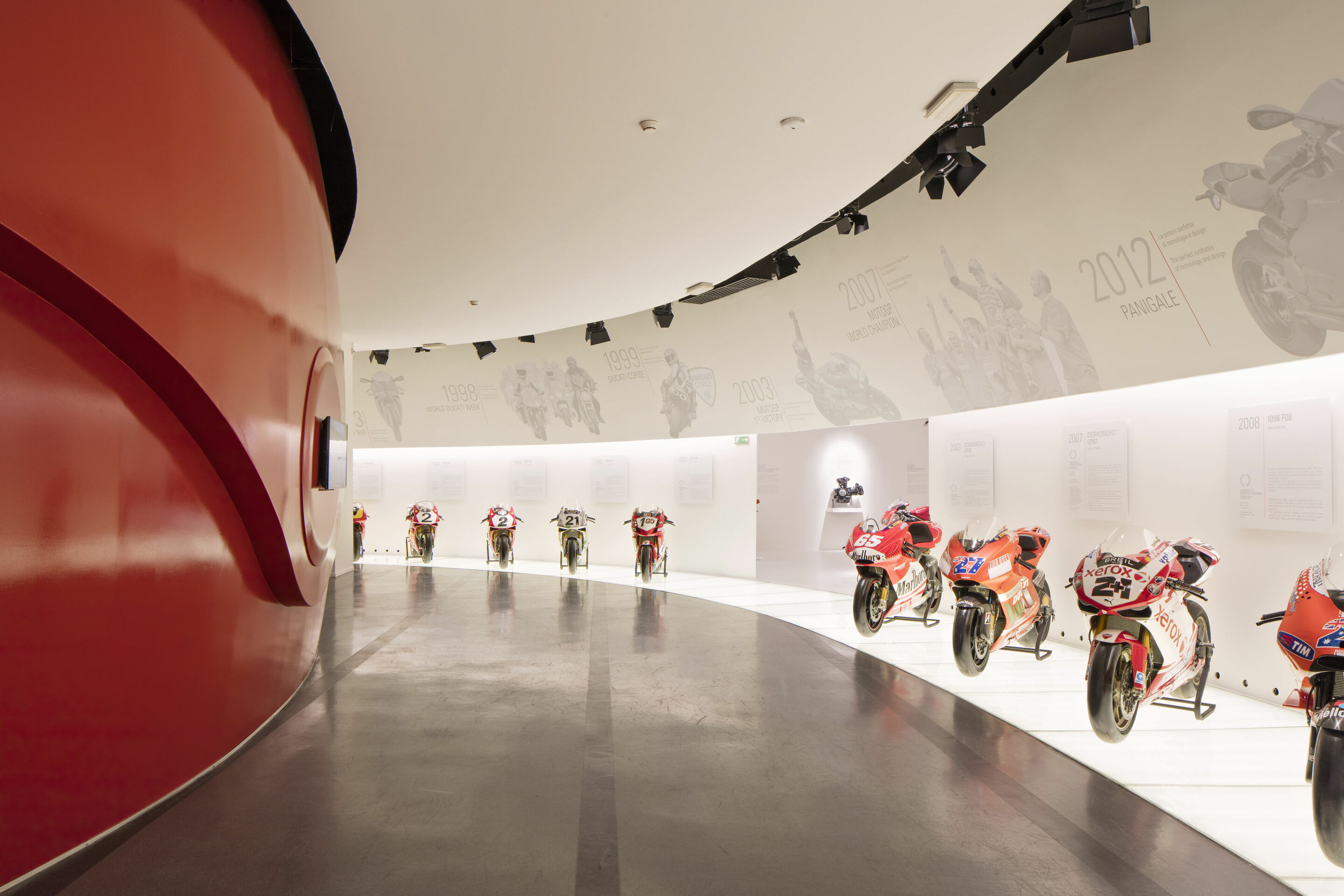History
Back to overviewIn 1946, Ducati began production of its first motorcycle-related product: the Cucciolo was a bicycle with an auxiliary engine and a displacement of 48 cubic centimeters. The first complete Ducati motorbike rolled off the assembly line in 1949. Its engine was a further development of the Cucciolo. From the 1970s onwards, the V2 twins with vertical shaft drive caused a sensation. In 1987, the Ducati 851 laid the foundation for the model series of superbikes with liquid-cooled engines. The Ducati 916 set new standards in motorbike design in 1994. Today, Ducati's wide range of models, from the off-road specialist DesertX to the uncompromising Panigale V4 sports motorbike, meets the tastes of many motorbike enthusiasts from all over the world. In 2023, the Italian manufacturer from Borgo Panigale near Bologna delivered 58,224 motorbikes worldwide.
On July 4, 1926, the brothers Adriano, Bruno, and Marcello Ducati founded the Società Scientifica Radiobrevetti Ducati. The first products were capacitors for radios and radios. In 1954, the company was split into Ducati Elettronica S.p.A. and the motorbike manufacturer Ducati Meccanica S.p.A. In 1956, Italian motorbike designer Fabio Taglioni ushered in the era of Ducati's typical desmodromic system, the forced valve control system that dispenses with valve springs and enables high engine speeds.
At the beginning of the 1980s, Ducati was only producing around 3,000 motorbikes a year under the control of IRI - EFIM - Finmeccanica. On June 1, 1983, IRI - EFIM - Finmeccanica announced a joint venture with Cagiva. Two years later, Cagiva took over the company completely. At the time, the brand promised to retain the Ducati brand name with its own model range. In 1996, Ducati had serious difficulties - production fell from 20,989 motorbikes in 1995 to 12,509. Following a slump in sales in 1996, the US-based Texas Pacific Group (TPG) and Cagiva founded the joint venture Ducati Motor. In 1998, TPG bought the remaining 49 percent of Ducati from Cagiva.
2006 was a year of anniversaries: 80 years of Ducati, 60 years of motorbike production, and 50 years of desmodromics. In the same year, TPG sold its 30 percent stake in Ducati to Investindustrial Holding. In April 2012, Audi and the previous owner, Investindustrial, announced that Audi would acquire 100 percent of the shares in Ducati Motor Holding. Following approval by the antitrust authorities, Ducati was integrated into the Audi Group and thus into the Volkswagen Group. Since then, Ducati has recorded continuously rising sales figures.
From a technical point of view, Ducati had been focussing on the 90° V-engine with upright cylinders in the direction of travel since the early 1960s, as would later become typical for Ducati engines. The era of the air-cooled "L-Twin" began in 1971 with the Ducati 750 GT, with which the engineers achieved lower vibrations and better cooling.
In 1987, with the Ducati 851, the brand laid the foundation for the superbike model series with liquid-cooled engines and four valves per cylinder.
In 1994, the Ducati 916 impressed with its racing-inspired design. From 1993 onwards, the air-cooled Ducati Monster became a successful model, and its increasing unit sales brought the brand back into the circle of top-selling European motorbike manufacturers.
In 1988, Ducati took part in the Superbike World Championship with the Ducati 851 in its debut season. Over the years, Ducati has won 16 riders' and 20 manufacturers' titles, over 400 victories and more than 1,000 podium finishes, establishing itself as the most successful team in this racing series.
In 2002, Ducati decided to start developing a MotoGP bike and presented the prototype of the Desmosedici. In 2007, Ducati won the MotoGP riders' title for the first time with Casey Stoner. In 2022 and 2023, Francesco Bagnaia repeated this feat by winning the title on the Desmosedici GP, and in 2024, Ducati dominated once again thanks to Jorge Martín’s victory.
Opened in 1998, the Ducati Museum in Bologna tells the story of the brand through its production motorbikes, the brand’s great racing heritage, and the history of the company. The museum houses more than 45 legendary motorcycles, 27 racing bikes, and 18 road motorcycles.
